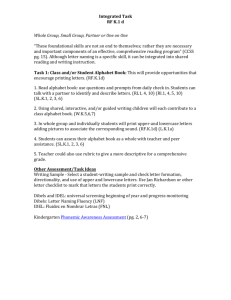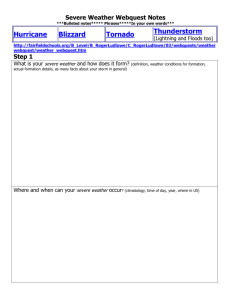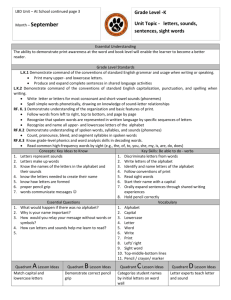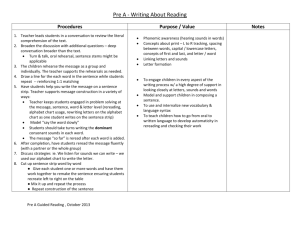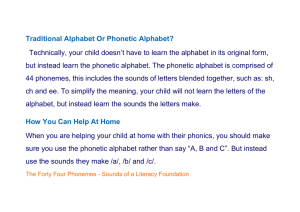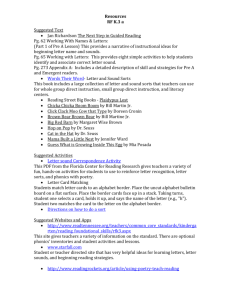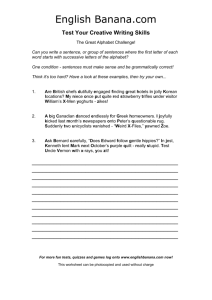Alphabet Soup
advertisement
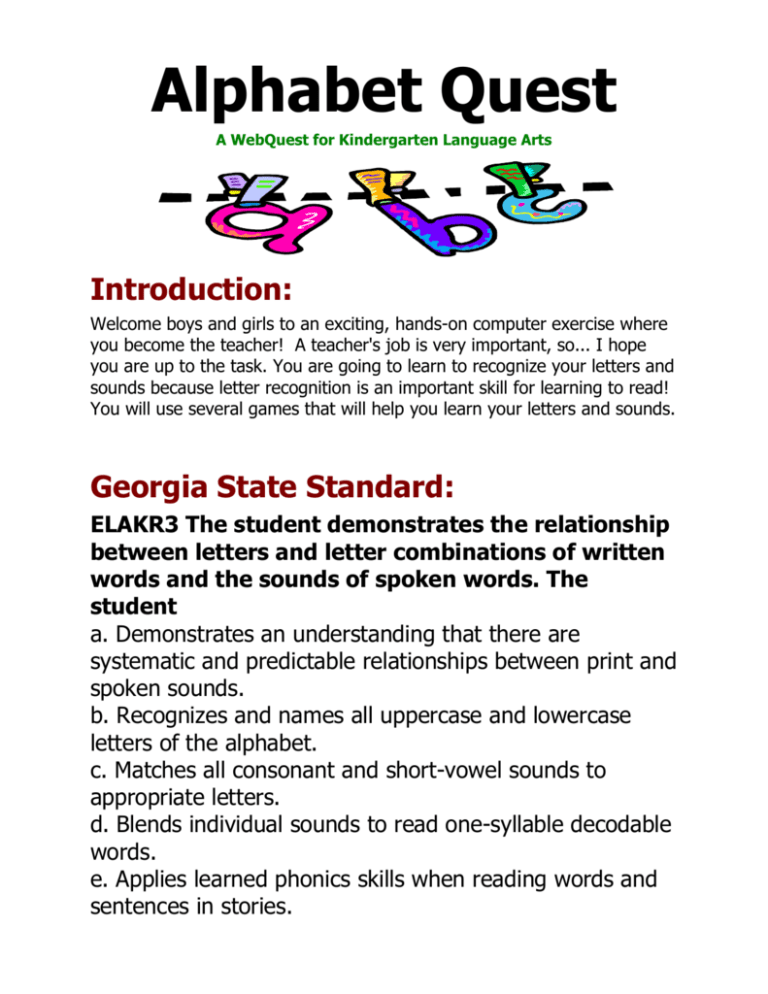
Alphabet Quest A WebQuest for Kindergarten Language Arts Introduction: Welcome boys and girls to an exciting, hands-on computer exercise where you become the teacher! A teacher's job is very important, so... I hope you are up to the task. You are going to learn to recognize your letters and sounds because letter recognition is an important skill for learning to read! You will use several games that will help you learn your letters and sounds. Georgia State Standard: ELAKR3 The student demonstrates the relationship between letters and letter combinations of written words and the sounds of spoken words. The student a. Demonstrates an understanding that there are systematic and predictable relationships between print and spoken sounds. b. Recognizes and names all uppercase and lowercase letters of the alphabet. c. Matches all consonant and short-vowel sounds to appropriate letters. d. Blends individual sounds to read one-syllable decodable words. e. Applies learned phonics skills when reading words and sentences in stories. Essential Questions for this Webquest: Why do we need so many letters? What happens when you put letters together? What are the relationships between sounds and the symbols? What are words? Where do we find words? How can letters change words? What if we could not read and understand words? The Tasks: The teacher will help you get started on the activities. You will learn many things by doing the activities in this WebQuest. o Follow directions when working on the WebQuest. o With a buddy, identify the letters of the alphabet at www.starfall.com. o Now, it is time for some Alphabet Action. Click on the green arrow to see each letter in action. o Now, match capital letters to lowercase letters with Alphabet Letter Puzzle. o Remember when working that we should create our own original work. If you copy someone’s work it is called PLAGIARISM. Let’s watch this short video clip to learn about plagiarism. Now that you know about plagiarism, draw a picture to show what plagiarism means. The Process: Here are some great sites and lessons for helping children learn letter recognition. I have put these sites in order so that the learner will be progressively challenged as they move through the activities. Lesson 1: View this fun video of letters. As you watch this video, pay close attention to the letters on the coconut tree. “Chicka Chicka Boom Boom” Lesson 2: During this treasure hunt, you will get solid practice in learning to recognize letters and sounds, using things you can touch. Pirates ahoy! Thar be learning in this here treasure hunt! Follow these directions: Get a set of 26 bags (brown paper lunch sacks work fine). Label each bag with one letter of the alphabet. Pirates, you’re about to embark on a treasure hunt. Together, you’ll find items to fill each of the treasure bags. But here’s the catch: you must look for objects whose names begin with the letter on each bag. (For example, A=apple, B=ball, C=car, etc.) I will help you sort through the classroom to find objects for each of your bags. Think about what you hear at the beginning of the word when you say its name All right pirates, review! Once each bag has at least one object, hold up the treasures, and say their names. Lesson 3: I really enjoyed the treasure hunt, but how about a little more action. Let’s go over to The Learning Planet and see if we can't find something a little more exciting. When you get to The Learning Planet, click on the green arrow to begin the game. Once the game begins, you choose the letter by using your mouse to click on the letter. Lesson 4: Let’s take a walk down Sesame Street Big Bird, Bert, and Ernie are all waiting just for you. Let’s see what the whole crew is up to. When you get to Sesame Street you will have to click your mouse on the red ABC sign to begin the game. Then you have to click on one of the pictures in the frame to begin. You will have to look hard to find the hidden letters. When you find the hidden letter, click your mouse on it. Lesson 5: Let’s see what you have learned. ABC Order will push you to your limits and put a smile on your face while doing it. When you get to this site, click your mouse on the green arrow to begin. Choose the correct letter by clicking on it with the mouse. The Evaluation: This is how you will be graded. Beginning 1 Following directions. Identifies the letters of the alphabet. Matches lowercase letters to capital letters. Developing 2 Has some difficulty moving Has difficulty moving through interactive through activities. interactive activities with assistance. Accomplished Exemplary Score 3 4 Can move through the interactive activities with minimal assistance. Can move through interactive activities with no assistance. Can identify most of the letters Can identify all of the letters. Cannot identify any letters Can identify some letters. Cannot match any lowercase letters to capital letters. Can match Can match all some Can match most lowercase lowercase lowercase letters letters to letters to to capital letters. capital capital letters. letters. Can put all Can put some Puts letters in Can put most of of the Cannot put any letters of the letters the correct the letters in the letters in in the correct order. in the correct order. correct order. the correct order.. order. Conclusion: Did you enjoy your alphabet soup? I hope you did! Remember letter recognition is an important skill. Letter recognition is the first step towards being able to read. I hope you come back often to develop your letter recognition skills at Alphabet Soup. Credits & References: Kayleigh's Playground, Learning Planet, Sesame Street, United Streaming, Alphabet Soup original Webquest, Pirates Treasure Hunt, and PBS KIDS websites were used in the construction of this WebQuest. Teacher Advice: This WebQuest was designed for Kindergarten children. An adult (such as a parent) will need to guide the child through the WebQuest to the appropriate interactive games. Once the child gets to the interactive games they may or may not need your assistance based on their level. These interactive games are put in order according to difficulty level. Some games may be very challenging for a Kindergarten student. These games were designed to address all levels ability.
